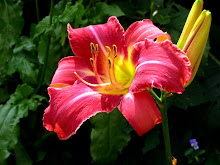
The other day I noticed a blurb on the cover of a popular back-to-the-earth-type magazine that shouted something like “Insect-Proof Your Garden!” Knowing this is another one of those headlines that promises more than it can deliver, I looked inside; sure enough, the article was all about the magic of having an insectary in your vegetable garden.
What’s that, you ask? Well, the idea is this: certain blossoms are known to attract beneficial insects, the kind that prey on the nasty bugs, slugs, mites, thrips, caterpillars and other baddies that gnaw on your carefully-tended veggies. It makes sense, then, to plant some of these flowers in or near your vegetable beds, therefore creating an “insectary,” an area that offers habitat, shelter, and an alternative food source for the good guys.
We did just that several years ago. The photo shows our insectary row on the left; bee balm, Shasta daisies, and rudbeckia were in bloom at the time. In addition, the row contains coneflower, lemon balm, yarrow, thyme, tansy, bronze fennel, angelica, and more; annuals often include sunflowers, cosmos, and cleome. Umbelliferous flowers – ones with umbrella-like blossoms, such as dill and Queen Anne’s lace, are particularly good ones for this purpose. You don’t need a huge assortment – half a dozen different types offer a variety of attractions, and they can be grown from seed.
Certain plants are much better than others for this purpose; google "insectary" to learn a whole lot more.
But, let’s get real: an insectary will not “insect-proof” your garden. Nothing will do that. It can help lessen the impact of the undesirable bugs, for sure; although I cannot measure it, it seems apparent to me that we have noticeably fewer insect issues since our insectary was established. It needs only weeding, and not too much of that if you mulch the plants well. And, perhaps less practical but certainly enjoyable, it adds beauty and color to the vegetable patch. What’s not to like about it?


No comments:
Post a Comment